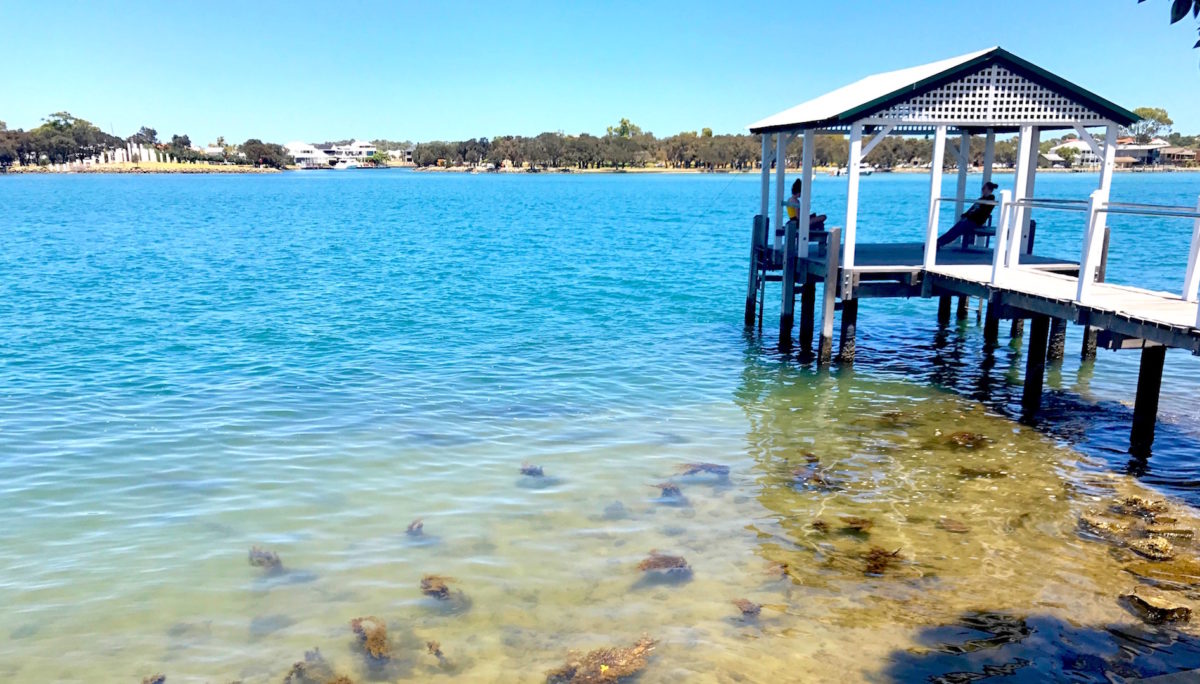Though – or maybe because? – our passport is so dire and our currency so unreliable, one great thing about being South African is that we tend to migrate all over the world. As a result, we sometimes find old friends in unexpected places.
One such Durban school and uni friend of mine, Susan Lazenby (née Hopkins), lives in the beautiful seaside city of Mandurah, an hour south by train from Perth, WA.

Perth Transport‘s Currambine Station is 2.8km from our home in Burns Beach, and the train whisks you south to central Perth in 26 minutes and from there to Mandurah at the far southern end of the line; it’s $12.60 for a Day Rider all-day ticket.
Susan, Russell and family made the move from Joburg to Mandurah 22 years ago. When they arrived, the population was 40,003 strong – “We were the 003,” she says; now it’s closer to 90,000.
Sue taught in Mandurah for 15 years, and now heads up the English department at St George’s Anglican Grammar School in the Perth CBD (www.stgeorges.wa.edu.au/). But it’s school holidays right now, so she was free to meet me at the station and spend all day showing me the place that has become her community.
Teachers tend to know everyone, and everyone knows them. What’s more, Susan is a woman with wide and varied interests and a thirst for knowledge.
That’s how she knows all about this magnificent Morton Bay fig tree on Stingray Point, planted around 1930 on the site of what was to become the hotel Pensinsula, which closed in 2003.

Artsy Stuff
This spherical artwork on the Mandjar Bay boardwalk was co-created by a Noongar artist and a design company; one of its facets features an image of Noongar leader Yaburgurt, who is buried in the churchyard of Susan’s church – Christ’s Church Anglican.


The name Mandurah comes from the Aboriginal Mandjoogoordap, meaning “meeting place of the heart” – it was the meeting place of the indigenous Australian “mobs”, meaning cohesive groups, often differentiated on the basis of their language. (Before white settlement, or “the invasion”, the multicultural Aboriginal population comprised 200 to 300 different language groups!)

Located right on Mandjar Bay, Mandurah’s splendid Performing Arts Centre was hosting a photographic and video exhibition titled Dead Centre. This travelling show features the work of three Australian artists on the theme of marginalisation. According to the programme, it “articulates some of the problematic expectations of the individual in finding their place in a social landscape characterised by simplistic and divisive assumptions”.

Home Run (2013), by Olga Cironis; We are blood and bone (2014), by Perth artist Abdul Abdullah
Going Walkabout
As long as you’re wearing your flatties, your sunnies and your hat, central Mandurah is eminently walkable. Dolphin Quay fulfilled the promise in its name – we saw two of the lovely mammals swim by in a leisurely search for lunch.





The original part of the pretty Christ’s Church Anglican Parish of Mandurah (built in 1829, rebuilt in 1871 after a fire) was tiny; it comprised just the end section of the building that was substantially extended in 1994.


Susan is an active church member, and remembers how her children used to say that all the local street names were buried in its graveyard!
Big, beautiful houses with stunning sea, estuarine or canal views are everywhere to be seen. Son Carl tells me that Mandurah “was hugely invested in” a decade or two ago, but for various reasons its commercial potential was never fully realised. It’s also “just that bit too far from Perth”, he says, and for many of the rich people who own property here, it’s their second home.

Lunch was a sumptuous picnic picked up at Woolworths and enjoyed in a shady spot on Halls Head Beach, locally known as Doddi’s Beach after journalist Rob Doddemeade’s restaurant, Doddi’s, which is now the site of a Dôme.
Seeded sourdough rolls filled with Philly cheese, smoked salmon, avo and baby leaves were heaps better than anything you could find in a chain café. Thanks, Susan! A strong wind had picked up, so the promised swim at Susan’s favourite waterhole will have to wait till next time.
Estuarine Escapades
South of Mandurah is the beautiful Peel-Harvey Estuary, comprising the Peel Inlet and the Harvey Estuary system – an amazing lake system with a combined surface area of more than 130 square kilometres. This is where Sue and Russell’s two children grew up swimming, crabbing and sailing.

Unlike my Roy, Susan completely understands stopping to photograph road signs – these two are at Dawesville, located on the estuary and home to a lot of picturesque paperbark trees. Near this carpark is a trail that leads to a spring, she says – but it’s tricky to find, and the site slithers with snakes.
We also visited Yalgorup National Park and its Lake Clifton, home to an impressive stretch of exceedingly rare thrombolites. Though they may look just like round, limestone-coloured rocks, each one is actually a living, growing microbial formation. Going back some 3.5 billion years, these prehistoric “living fossils” are able to photosynthesise, and are thought to be responsible for the oxygen production that allowed life to exist on planet Earth.
Rare stretch of thrombolites on the edge of Lake Clifton, Yalgorup National Park
Just south again of Yalgorup, we stopped at Cape Bouvard Winery for something cold to drink. Susan suggested a walk through this nature reserve, but relented when I baulked at the thick swathes of spider webs that spanned the path at not much more than head-height.

Such a lovely day out with an old girl friend reminds me how important it is to have time away from your husband or significant other – especially after retirement. For one thing, how can you miss someone if they won’t go away?





























So true Verne. It is great to have a day out with a good friend. It is good for the soul.